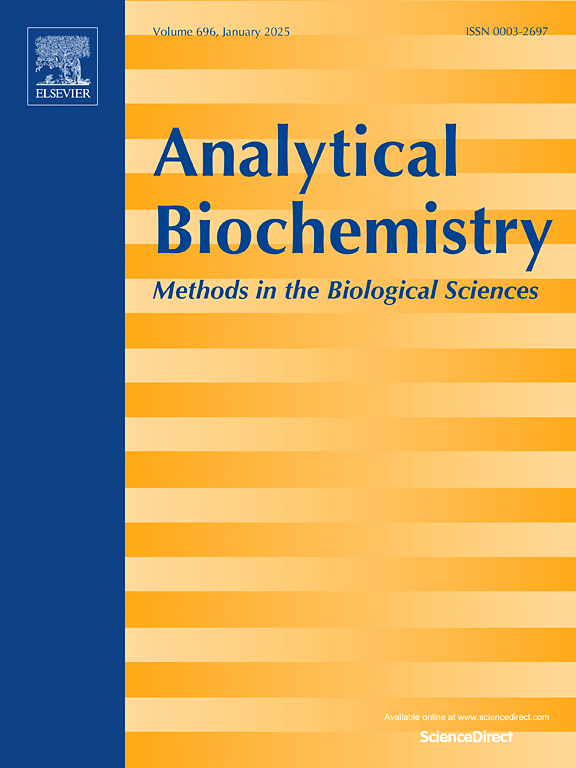Cryopreserved PBMCs can be used for the analysis of mitochondrial respiration and serve as a diagnostic tool for mitochondrial diseases
IF 2.6
4区 生物学
Q2 BIOCHEMICAL RESEARCH METHODS
引用次数: 0
Abstract
Mitochondrial diseases are severe, inherited metabolic disorders that affect the paediatric population. They affect the functioning of mitochondrial oxidative phosphorylation (OXPHOS) apparatus either directly or indirectly. Since mutations in mtDNA are responsible for only 25 % of paediatric cases and next-generation sequencing does not always provide a conclusive diagnosis, the biochemical approach still represents a valuable tool in diagnostics. Mitochondrial defects can be identified in tissue biopsies (muscle or skin). However, they also often manifest in peripheral blood cells. We developed a protocol for isolation and cryopreservation of peripheral blood mononuclear cells (PBMCs) from 5 ml of children's blood using Ficoll centrifugation which can be utilised for subsequent functional measurements on thawed samples. Furthermore, we evaluated the diagnostic utility of the optimised high-resolution oxygraphy protocol using digitonin-permeabilized cryopreserved PBMCs on 47 samples from patients with confirmed or suspected mitochondrial disease. Overall, the diagnosis was confirmed in 72 % of cases, while the analysis of cryopreserved PBMCs provided a false negative outcome in 13 % of cases. Our study demonstrates a sensitive, fast, and non-invasive approach for the diagnostics of various types of mitochondrial disorders, especially those of nuclear genetic origin manifesting in paediatric patients.

冷冻保存的pbmc可用于线粒体呼吸分析,并可作为线粒体疾病的诊断工具。
线粒体疾病是严重的遗传性代谢紊乱,影响儿科人群。它们直接或间接地影响线粒体氧化磷酸化(OXPHOS)装置的功能。由于mtDNA突变仅占儿科病例的25%,而下一代测序并不总是提供决定性的诊断,因此生化方法仍然是诊断中的一种有价值的工具。线粒体缺陷可以在组织活检(肌肉或皮肤)中发现。然而,它们也经常表现在外周血细胞中。我们开发了一种分离和冷冻保存5ml儿童血液外周血单个核细胞(PBMCs)的方案,该方案可用于随后对解冻样品的功能测量。此外,我们评估了优化的高分辨率氧成像方案的诊断效用,使用地黄苷渗透的冷冻保存pbmc对47例确诊或疑似线粒体疾病患者的样本进行了诊断。总的来说,诊断在72%的病例中得到证实,而冷冻保存的pbmc分析在13%的病例中提供假阴性结果。我们的研究展示了一种敏感、快速和非侵入性的方法,用于诊断各种类型的线粒体疾病,特别是在儿科患者中表现出的核遗传起源的疾病。
本文章由计算机程序翻译,如有差异,请以英文原文为准。
求助全文
约1分钟内获得全文
求助全文
来源期刊

Analytical biochemistry
生物-分析化学
CiteScore
5.70
自引率
0.00%
发文量
283
审稿时长
44 days
期刊介绍:
The journal''s title Analytical Biochemistry: Methods in the Biological Sciences declares its broad scope: methods for the basic biological sciences that include biochemistry, molecular genetics, cell biology, proteomics, immunology, bioinformatics and wherever the frontiers of research take the field.
The emphasis is on methods from the strictly analytical to the more preparative that would include novel approaches to protein purification as well as improvements in cell and organ culture. The actual techniques are equally inclusive ranging from aptamers to zymology.
The journal has been particularly active in:
-Analytical techniques for biological molecules-
Aptamer selection and utilization-
Biosensors-
Chromatography-
Cloning, sequencing and mutagenesis-
Electrochemical methods-
Electrophoresis-
Enzyme characterization methods-
Immunological approaches-
Mass spectrometry of proteins and nucleic acids-
Metabolomics-
Nano level techniques-
Optical spectroscopy in all its forms.
The journal is reluctant to include most drug and strictly clinical studies as there are more suitable publication platforms for these types of papers.
 求助内容:
求助内容: 应助结果提醒方式:
应助结果提醒方式:


